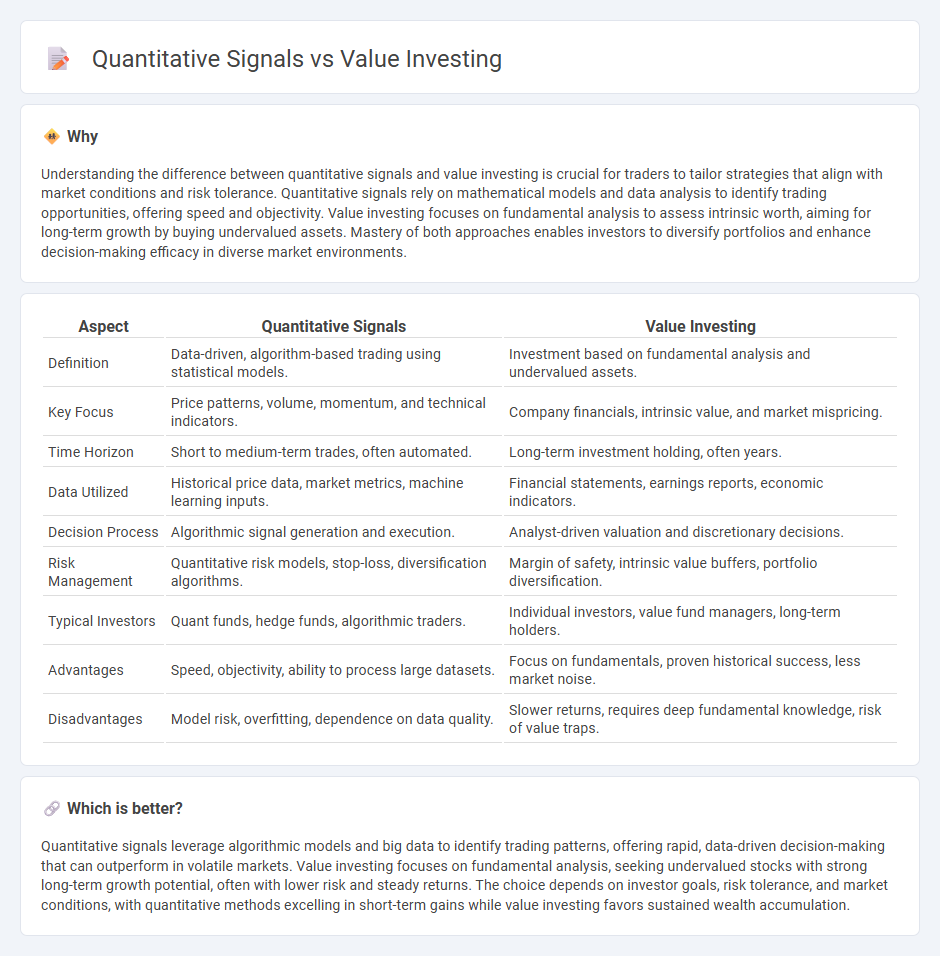
Quantitative signals leverage advanced algorithms and statistical models to identify trading opportunities based on large datasets and real-time market analysis. Value investing focuses on fundamental analysis to find undervalued assets with strong long-term growth potential by examining financial statements and market conditions. Discover the strengths and applications of both strategies to enhance your trading approach.
Why it is important
Understanding the difference between quantitative signals and value investing is crucial for traders to tailor strategies that align with market conditions and risk tolerance. Quantitative signals rely on mathematical models and data analysis to identify trading opportunities, offering speed and objectivity. Value investing focuses on fundamental analysis to assess intrinsic worth, aiming for long-term growth by buying undervalued assets. Mastery of both approaches enables investors to diversify portfolios and enhance decision-making efficacy in diverse market environments.
Comparison Table
| Aspect | Quantitative Signals | Value Investing |
|---|---|---|
| Definition | Data-driven, algorithm-based trading using statistical models. | Investment based on fundamental analysis and undervalued assets. |
| Key Focus | Price patterns, volume, momentum, and technical indicators. | Company financials, intrinsic value, and market mispricing. |
| Time Horizon | Short to medium-term trades, often automated. | Long-term investment holding, often years. |
| Data Utilized | Historical price data, market metrics, machine learning inputs. | Financial statements, earnings reports, economic indicators. |
| Decision Process | Algorithmic signal generation and execution. | Analyst-driven valuation and discretionary decisions. |
| Risk Management | Quantitative risk models, stop-loss, diversification algorithms. | Margin of safety, intrinsic value buffers, portfolio diversification. |
| Typical Investors | Quant funds, hedge funds, algorithmic traders. | Individual investors, value fund managers, long-term holders. |
| Advantages | Speed, objectivity, ability to process large datasets. | Focus on fundamentals, proven historical success, less market noise. |
| Disadvantages | Model risk, overfitting, dependence on data quality. | Slower returns, requires deep fundamental knowledge, risk of value traps. |
Which is better?
Quantitative signals leverage algorithmic models and big data to identify trading patterns, offering rapid, data-driven decision-making that can outperform in volatile markets. Value investing focuses on fundamental analysis, seeking undervalued stocks with strong long-term growth potential, often with lower risk and steady returns. The choice depends on investor goals, risk tolerance, and market conditions, with quantitative methods excelling in short-term gains while value investing favors sustained wealth accumulation.
Connection
Quantitative signals enhance value investing by providing data-driven metrics to identify undervalued stocks based on financial ratios such as price-to-earnings and price-to-book values. Utilizing algorithmic models, traders can systematically analyze large datasets to uncover investment opportunities that align with intrinsic value principles. This integration enables more precise portfolio construction, risk management, and improved decision-making efficiency in value-oriented trading strategies.
Key Terms
Intrinsic Value
Value investing emphasizes identifying stocks trading below their intrinsic value based on fundamental analysis, such as earnings, cash flow, and book value. Quantitative signals apply algorithmic models and statistical methods to detect market anomalies and predict price movements without directly assessing intrinsic value. Explore comprehensive insights into intrinsic value assessment and investment strategies to enhance portfolio performance.
Fundamental Analysis
Value investing centers on fundamental analysis, emphasizing intrinsic company metrics like earnings, book value, and cash flow to identify undervalued stocks. Quantitative signals apply mathematical models and large datasets to automate stock selection, often integrating financial ratios but relying heavily on algorithmic patterns. Explore the nuanced strengths of both approaches and how combining them can enhance investment strategies.
Backtesting
Value investing relies on fundamental analysis to identify undervalued stocks based on metrics like price-to-earnings and book-to-value ratios, while quantitative signals use statistical models and algorithms to predict price movements backed by historical data. Backtesting in quantitative investing validates signal reliability by simulating trades over past periods, assessing performance metrics such as Sharpe ratio and drawdown to optimize strategies. Explore how integrating backtesting techniques enhances decision-making in both value investing and quantitative signal analysis.
Source and External Links
Value investing - Value investing is an investment strategy focused on buying securities that are undervalued compared to their intrinsic value, originally developed by Benjamin Graham and David Dodd through fundamental analysis, emphasizing a "margin of safety" by purchasing stocks below their true worth.
What is value investing? | iShares - BlackRock - Value investing involves identifying stocks that are cheap relative to their real worth, using financial metrics like price-to-book and price-to-earnings ratios, and can be accessed today through ETFs targeting undervalued stocks across various sectors.
Value Investing History | Columbia Business School - Developed in the 1920s by Benjamin Graham and David Dodd at Columbia Business School, value investing is a methodology that estimates a stock's true intrinsic value to identify and purchase securities priced well below this value, aiming for price and intrinsic value convergence over time.
 dowidth.com
dowidth.com